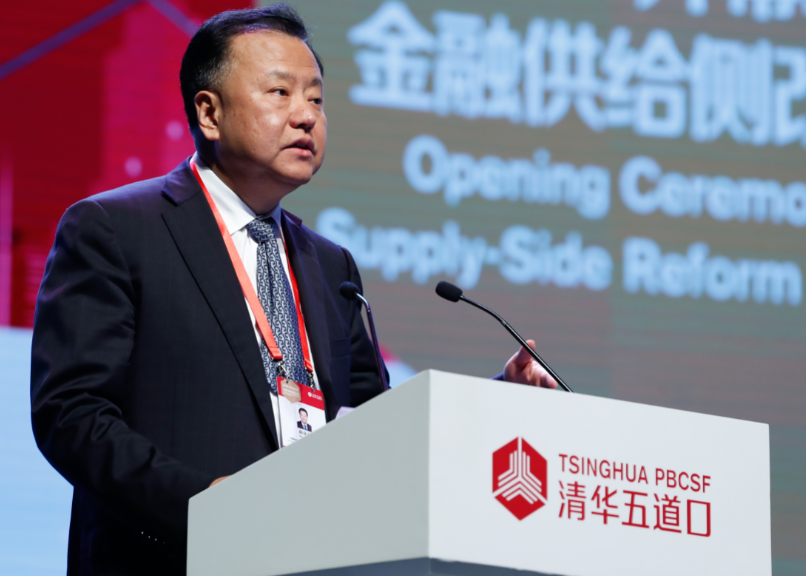
YAN Qingmin Vice Chairman, China Securities Regulatory Commission (CSRC); Member of the CPC CSRC Committee
On May 25, Beijing — With the theme of "Financial Supply-Side Reform and Opening-Up" this year, the Tsinghua PBCSF Global Finance Forum focuses on financial systematic risk, and seeks to address pressing issues from stabilizing economic growth, further opening up of market with oversupply of money and undersupply of capital, adopting supply-side reform. China's top finance leaders and academics attended to this forum which is hosted by Tsinghua University and organized jointly by the Tsinghua University PBC School of Finance and Tsinghua University National Institute of Financial Research.
The forum has set a total of nine themed panels, including "Financial Supply-Side Reform and Opening-Up", "Capital Market and Technological Innovation," "Reform and Opening-Up in the Changing World," "Fintech Education and Research 50 Forum", "Integration of Fintech and Traditional Finance," "Finance-Driven High-Quality Development of Culture Industry," "Finance-Driven National Sports Economic System Construction," and "Wealth Management : Opportunities and Challenges", as well as two evening sessions.
Highlight of Yan Qingmin's keynote speech:
The Chinese government has been focusing on the so-called "supply-side reform" and preventing systemic risk since late 2016. In terms of adopting the supply side-reform, Yan Qingmin, Vice Chairman of China Securities Regulatory Commission (CSRC), proposed four perspectives of financial supply-side reform. According to Yan's speech, an oversupply of money and undersupply of real capital is featuring current Chinese financial system. To deepening financial supply-side structural reform, regulators need tensions to optimization. Direct financing, especially in bank lending, is the dominant source of China. "To tackle this issue, we need to focus on the structure of the financial system in China," said Yan Qingmin. Among the 90 financial institutions in China, the majority of them are banks, mainly listed, do not profitable enough as financial institutions, even they present 44 percent of China's market capitalization. But non-financial institutions are numbered over 3000, mostly small and medium-sized. China needs to focus on the further development of the capital market.
Moreover, China's financial reform need to resolve the constants for the development of market balance. The financial market is imbalanced, inadequate, especially for the equity market recommended to the consistency of healthy bond market — ninety trillion-yuan worth of outstanding bond stocks, including treasures of a financial bond, corporate bonds.
Secondly, Yan emphasize that acceleration of financial institution reform is as a critical driver of the financial supply-side of reform and opening up. CSRC has been promoting inclusive finance in different banks; big against small. Concerning, the rural area, about half a billion people, accounting for 40 percent of the Chinese population, get only less than 20 percent of financial access.
Next, he pointed out China's policy-based finance sector is not sufficiently developed. So creating new capital is key to a component of supply-side reform. The venture capital market has enormous potential to create new capital. Right now, China's financial products are lagging in terms of thinking, not so diversified. So China needs to create more multi-layered products when the transitional period of moving from heavy-asset to light asset. Additionally, he told the participants of the forum that adaptability, flexibility, safety, liquidity, and profitability are the priorities to focus on development.
Finally, Yan expressed his thought on risk aversion. The financial system needs to improve its risk aversion, guard against different kind of risks, including liquidity. Listed companies in China accounts for 11.6 percent of derived market participation, whereas among the top 500 companies of the world, 90.4 percent of them are involved in the acquired business. Efficient improvement of financial regulation safeguards the financial supply-side reform. To improve the efficiency of risk management, consistency of financial regulation needs matches the real economy, strengthen the breaching activities and safety financial regulation.
Yan emphasized that regulation should not be standing the way of the real economy. The regulator should maintain the balance, like riding a bicycle. Sometimes rules are lagging far behind the real economy and financial market developments. The leadership of the Financial Stability Committee concept deals with the regulation in a more proper way.
Moreover, Yan expressed his point on breaching. "To improve the quality of listed companies, we need to increase the cost of irregularities and regulation breaching activity," Yan said. For instance, 330 cases were given a total amount of 10 billion RMB penalties, a record-breaking number, last year. In terms of the key players of the capital market, listed companies should increase their qualities; we need to regulate it a proper way.